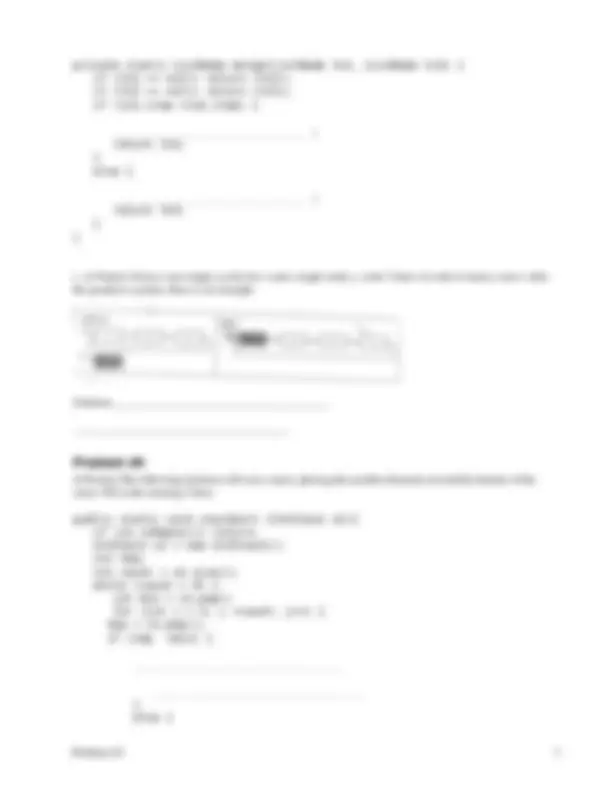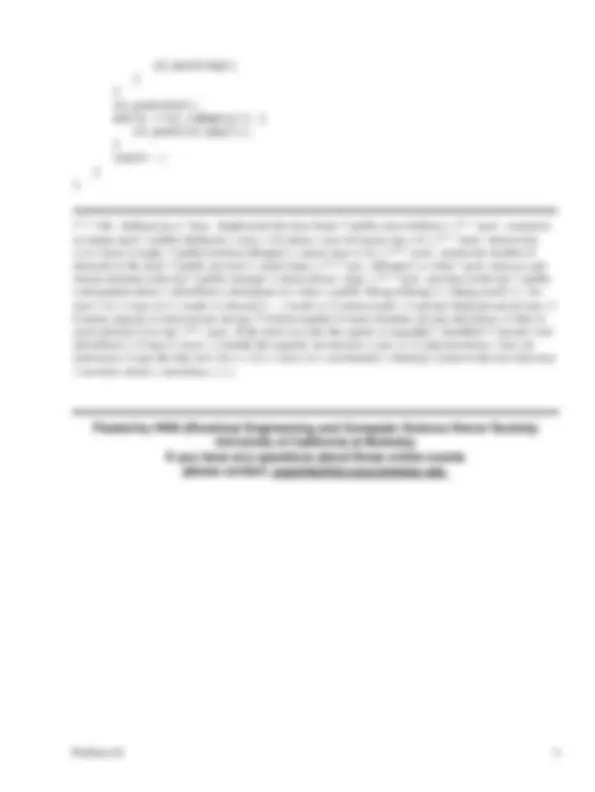




Study with the several resources on Docsity

Earn points by helping other students or get them with a premium plan


Prepare for your exams
Study with the several resources on Docsity

Earn points to download
Earn points by helping other students or get them with a premium plan
Community
Ask the community for help and clear up your study doubts
Discover the best universities in your country according to Docsity users
Free resources
Download our free guides on studying techniques, anxiety management strategies, and thesis advice from Docsity tutors
Cs61b midterm #1 problem set for professor k. Yelick's fall 1997 class. The problem set includes three problems related to java programming concepts such as method call, list manipulation, and stack sorting.
Typology: Exams
1 / 4

This page cannot be seen from the preview
Don't miss anything!



(2 points) What is y after the following code executes?
static void addOne (int x){ x += 1; } int y = 3; addOne(y);
Answer:
(8 points) Answer questions about the following classes. For parts b-e, choose one of the following:
CE: The code will result in a compiler error from javac. RT: The code will compile without errors, but will cause an error of some kind run time. OK: The code will compile and run without errors. Show what the program will print.
abstract class A { abstract public void foo (); } class B extends A { public void foo () { System.out.println("Calling B.foo");} protected int value = 0; } class C extends B { public void foo () { System.out.println("Calling C.foo," + value);} } class D extends C { public void foo () { System.out.println("Calling D.foo()," + value);} }
a. (2 points)
A a1 = new A(); a1.foo();
CS61B, Fall 1997 Midterm #1 Professor K. Yelick 1
b. (2 points)
A a2 = new B(); a2.foo();
c. (2 points)
A a3 = new C(); a3.foo();
d. (2 points)
B b4 = new D(); ((C) b4).foo();
(12 points) Consider the following ListNode class definition.
class ListNode { int item; ListNode next; /** Postcondition: Constructs a new listnode containing i and n */ ListNode (int i, ListNode n) { item = i; next = n; } }
a. (4 Points) Complete the following code to copy a list.
/** Postcondition; returns a copy of l. (Copies all the nodes). */ private static ListNode copy(ListNode l) { if (l == null) return l; else { return (new ListNode (_____________ , _____________)); } }
b. (4 Points) Complete the following code to merge 2 sorted lists.
/** Precondition: ln1 and ln2 are sorted
s2.push(tmp); } } s1.push(min); while (!s2.isEmpty()) { s1.push(s2.pop()); } count--; } }
/** * file : IntStack.java * desc : Implements the class Stack / public class IntStack { /* * post : constructs an empty stack / public IntStack() { max = 10; elems = new int [max]; top = 0; } /* * post : returns true <==> stack is empty / public boolean isEmpty() { return (top == 0); } /* * post : returns the number of elements in the stack / public int size() { return (top); } /* * pre : isEmpty() == false * post: removes and returns element at the top / public int pop() { return elems[--top]; } /* * post : put elem at the top / public void push(int elem) { checkSize(); elems[top++] = elem; } public String toString () { String result = [ ; for (int i = 0; i < top; i++) { result += elems[i] + ; } result += ]; return result; } // private fields private int max; // Current capacity of stack private int top; // Current number of stack elements. private int[] elems; // Data in stack (elems[t-1] is top). /* * post : If the stack was full, the capcity is expanded * (doubled) */ private void checkSize() { if (top == max) { // double the capacity int newmax = max << 2; int[] newelems = new int [newmax]; // copy the data int i; for ( i = 0; i < max; i++ ) newlems[i] = elems[i]; // point to the new data max = newmax; elems = newelems; } } }